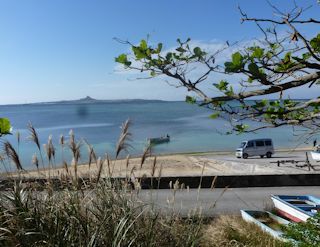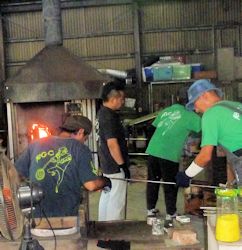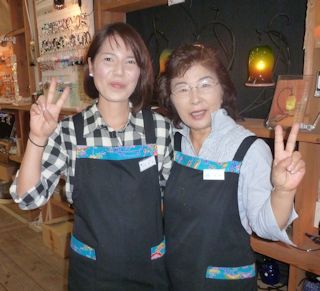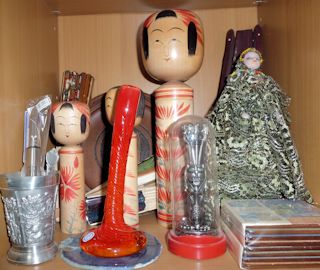|
| 1st Day |
|
Outline |
| 2nd Day |
|
Mangrove Forest, Cape Hedo, Kouri-jima Island, Shuri Castle |
| 3rd Day |
|
Tower of Lilies, Peace Memorial Park, Gyokusendo Cave, Ryukyu Village |
| 4th Day |
|
Katsuren Castle Remains, Manzamo, Tree Tunnel, Nakijin Castle Remains |
| 5th Day |
|
This and That |
|
|
|
| 4.Fourth Day, November 22nd |
|
We have been staying at Costa Vista Okinawa Hotel, on the hillside in Kita-Nakagusuku
Village. I got up at 6:00.
It rained considerably at night. It is still raining slightly now. I can
see puddles on the road lit by outdoor lamps through the window. The last
sightseeing day with rain!
Breakfast at 6:40. Left the hotel at 8:00.
The first visit is Katsuren Castle Remains, and then Manzamo, Bise Fukugi
Tree tunnel, and the last will be Nakijin Castle Remains. We have to prepare
for some trouble during strolling because of the rain.
|
|
| Katsuren Castle Remains
While our bus was running about one hour, luckily the rain began letting
up and a little sunshine appeared.
I felt happy getting off the bus. There were some people under umbrellas,
but almost unnecessary.

Katsuren Castle Remains was at the base in the south area of Okinawa facing
Pacific Ocean. We did not have much trouble climing the hill to get there.
It was built in 11th-12th century and restored by Lord Amawari afterward,
but was destroyed in 1458 by Ryukyu Kingdom.
The castle made skillful use of the natural cliff, and is called a ladder-type
castle. The 1st keep is 97 meters high and the 4th keep is 63 meters high.
Mr. B, an architect, told me that the stone walls not angular were rare.
I agreed as it looked worthwhile. From there we could have a wide view
of the sea.
Manzamo
It is a scenic spot facing the East China Sea just in the middle through
Okinawa Main Island.
We drove across for about 1 hour from Katsuren and arrived here.
As you notice, the large rock like an elephant nose is sticking out.
According to Wikipedia, "It is known that there are special plants
growing only here in Okinawa and so this spot is designated as Colony of
Limestone Plants of Manzamo." I am ashamed I overlooked.
Bise Fukugi (Garcinia) Tree Tunnel
This tree tunnel was at the corner of Motobu Peninsula northwest of Okinawa
Main Island.
When we entered the row of Fukugi trees, the sunshine filtering blocked through the leaves were so comfortable.
We walked lowering our voice, as there were houses both sides.

The evergreen high tree, Fukugi (Garcinia), a hypericaceae, came from Taiwan
and the Phillipines.
I realized that the Bise Fukugi tunnels had been an instrumental windbreak
against typhoons.
Ie-jima Island was viewed beyond the Emerald Beach.

Nakijin Castle Remains
This site is located in Nakijin Village, northwest of Okinawa Main Island. It is also called Hokuzan Castle, where King Hokuzan lived in 14th century before the birth of Ryukyu Kingdom.
After destroyed in 15th century, it remained as a strategic point for reigning
old Hokuzan, and the important attack target when Satsuma domain invaded
Ryukyu in 1609.
Both sides of stone steps to the castle were lined by winter cherry trees.
They are said to come into flowers from the end of January.
The Gusuku Sites and related properties of the Kingdom of Ryukyu were registered
as an UNESCO World Heritage Site in 2000 which consist of nine sites all
located in Okinawa Prefecture. Among them we visited Shuri Castle, Katsuren
Castle Remains and Nakijin Castle Remains.
According to a certain travel book, "The sites were inscribed based
on the criteria that they were a fine representation of the Ryukyu Kingdom's
culture, whose unique blend of Japanese and Chinese influence made it a
crucial economic and cultural junction between several neighboring states."
--------------------
Glass House in Forest
 We called at Glass House in Forest before lunch on the way to Fukugi Tree
Tunnel. We called at Glass House in Forest before lunch on the way to Fukugi Tree
Tunnel.
It was the studio and gallery shop managed by Ryukyu Glass Village.
After making a studio tour where they were producing Ryukyu glasses, we
entered the shop of on-the spot-sale.
There were a lot of works on the shelves. Looking at them around with my
another eye on the prices, I noticed two ladies working hand-made glass
craftsmanship.
When they stopped the work, I talked to them in the Okinawa dialect just
learned.
"Unjo ippe chura kagi." (You are beautiful.)
Both of them answered at once in unison.
"Hedebiru." (Thank you.)

One of them helped my shopping and chose a small flower vase for me.
 |
| At the gallery |
 |
In the shelf on my desk
It is a little left in persimon color. |
Maybe superfluous, but this Ryukyu glass seems to be originated after the
Pacific War.
The US troops stationed here brought a lot of empty drinking bottles. They
were melted and were born again as a Ryukyu glass.
As it was a good use of junk bottles, impurities were mixed as a matter
of fact. On the contrary, this situation bore the result of unique taste.
(This is not my opinion, just to make sure.)
|
| -------------------- |
|
On the way from Nakijin Castle Remains south to Onnason Village, the guide
Nakama-san seemed to say "KUNENBO", pointing at the trees of
mandarin or shikwaasaa.
Yes, it was true. She explained that the shikwaasaa (and mandarin) tree
is called Kunenbo (9 year fruit) in their dialect. These trees have their
fruits after 9 years and they become mothers in 9 years. That's why they
are called so.
Rather than this story, another idea came out to my mind. A rakugo story.
An apprentice carries 9 pieces of "KUNENBO" to a good customer.
On the way, he eats one and pockets another. He submits the remaining 7
pieces to a customer saying, "It's SHICHINENBO (7 year fruit)".
|
| -------------------- |
 |
With Ms. Nakama, the guide
at Katsuren Castle Remains |
|
|
| Reading 11'24" |
|
|
|
|
| 1st Day |
|
Outline |
| 2nd Day |
|
Mangrove Forest, Cape Hedo, Kouri-jima Island, Shuri Castle |
| 3rd Day |
|
Tower of Lilies, Peace Memorial Park, Gyokusendo Cave, Ryukyu Village |
| 4th Day |
|
Katsuren Castle Remains, Manzamo, Tree Tunnel, Nakijin Castle Remains |
| 5th Day |
|
This and That |
|
|
|
|
|
|
|